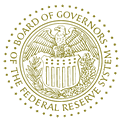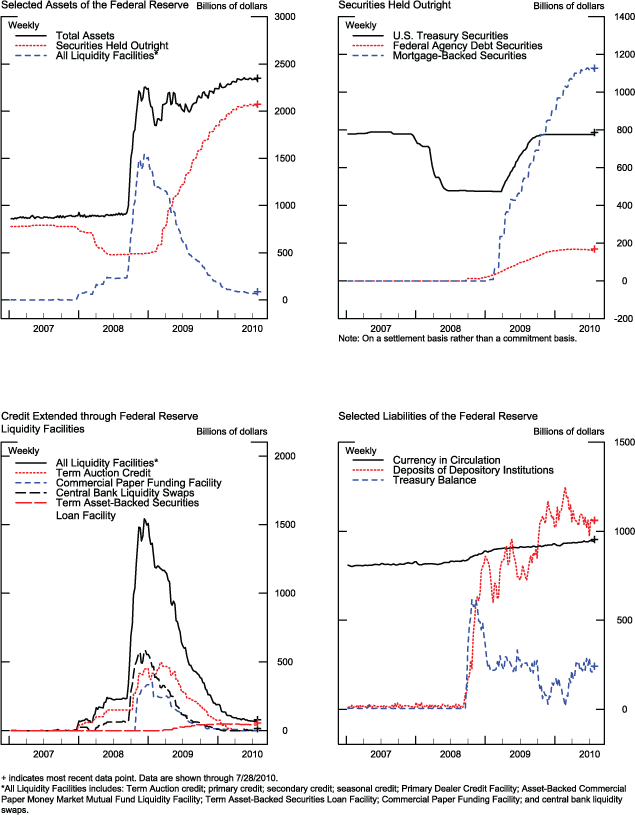Home
> Monetary Policy
> Quarterly Report on Federal Reserve Balance Sheet Developments
> Monthly Report on Credit and Liquidity Programs, 2010
> CLBS Report, August 2010


Monthly Report on Credit and Liquidity Programs
and the Balance Sheet
August 2010 (1.5 MB PDF PDF)
| Purpose | Overview | System Open Market Account (SOMA) |
Overview
Recent Developments
- On August 18, 2010, the Federal Reserve Bank of New York (FRBNY) published a list of money market funds that are now eligible to participate as counterparties to reverse repurchase transactions with the Federal Reserve. Each listed fund submitted an application and meets the criteria published by the FRBNY on March 8, 2010. Inclusion on the list does not constitute a public endorsement by the FRBNY of any listed counterparty and should not substitute for prudent counterparty risk management and due diligence. The list is available on the FRBNY's website at www.newyorkfed.org/markets/expanded_counterparties.html.
- On August 10, 2010, the Federal Open Market Committee (FOMC) announced that the Federal Reserve will maintain the level of securities holdings in the System Open Market Account (SOMA) portfolio by reinvesting principal payments from agency debt and agency mortgage-backed securities (MBS) in longer-term Treasury securities. As of August 4, 2010, outright holdings of domestic securities in the SOMA portfolio totaled roughly $2 trillion. The FRBNY has published a tentative schedule for Treasury security purchases on the FRBNY website at www.newyorkfed.org/markets/tot_operation_schedule.html.
- On August 3, 2010, the FRBNY announced that it would conduct a series of small-scale, real-value reverse repurchase transactions with primary dealers using all eligible collateral types, including, for the first time, agency MBS from the SOMA portfolio. The first transaction, using agency MBS as collateral, took place on August 4, 2010. The FRBNY has been conducting similar small-scale reverse repurchase transactions with primary dealers using U.S. Treasury and agency debt securities since late 2009. The purpose of these transactions is to refine the operational aspects of triparty reverse repurchase agreements to ensure that this tool will be ready if the FOMC decides it should be used. Like the earlier operational readiness exercises, this work is a matter of prudent advance planning by the Federal Reserve. It does not represent any change in the stance of monetary policy, and no inference should be drawn about the timing of any change in the stance of monetary policy in the future.
-
On July 21, 2010, the Dodd-Frank Wall Street Reform and Consumer Protection Act (the "Dodd-Frank Act") was signed into law.1 The Dodd-Frank Act modifies the Federal Reserve's authority to provide emergency liquidity to nondepository institutions under Section 13(3) of the Federal Reserve Act in light of other amendments that provide the U.S. government with new authority to resolve failing, systemically important nonbank financial institutions in an orderly manner. In addition, the Dodd-Frank Act includes changes that are designed to promote transparency while protecting monetary policy independence and the efficacy of the Federal Reserve's liquidity programs and open market operations (OMOs). For example:
- Going forward, any emergency lending programs and facilities authorized by the Federal Reserve under Section 13(3) of the Federal Reserve Act must have broad-based eligibility, and must be approved by the Secretary of the Treasury.
- The Federal Reserve must disclose certain information, by December 1, 2010, about entities that received loans or other financial assistance under a Section 13(3) credit facility between December 1, 2007, and July 21, 2010.2 Disclosure is also required for persons or entities that participated in the agency MBS purchase program, used foreign currency liquidity swap lines, or borrowed through the Term Auction Facility (TAF) during that time frame.
- The Dodd-Frank Act also establishes a framework for the delayed disclosure of information on entities that, after July 21, 2010, received a loan from the discount window under Section 10B of the Federal Reserve Act or from a Section 13(3) facility, or participated in OMO transactions. Generally, this framework requires the Federal Reserve to publicly disclose certain information about these discount window borrowers and OMO counterparties approximately two years after the relevant loan or transaction; information about borrowers under future Section 13(3) facilities will be disclosed one year after the authorization for the facility is terminated.
- The Federal Reserve plans to implement these new disclosure requirements in a timely and effective manner.
Table 1. Assets, Liabilities, and Capital of the Federal Reserve System
Billions of dollars
| Item |
Current July 28, 2010 |
Change from June 30, 2010 |
Change from July 29, 2009 |
|---|---|---|---|
| Total assets | 2,329 | -5 | 326 |
| Selected assets | |||
| Securities held outright | 2,054 | -6 | 709 |
| U.S. Treasury securities1 | 777 | +* | 81 |
| Federal agency debt securities1 | 159 | -6 | 53 |
| Mortgage-backed securities2 | 1,117 | -1 | 574 |
| Memo: Overnight securities lending3 | 6 | -8 | -3 |
| Memo: Net commitments to purchase mortgage-backed securities4 | 3 | -13 | -132 |
| Lending to depository institutions5 | * | -1 | -36 |
| Central bank liquidity swaps6 | 1 | +* | -87 |
| Lending through other credit facilities | 41 | -1 | -57 |
| Net portfolio holdings of Commercial Paper Funding Facility LLC7 | * | 0 | -67 |
| Term Asset-Backed Securities Loan Facility8 | 41 | -1 | 11 |
| Net portfolio holdings of TALF LLC9 | 1 | +* | 1 |
| Support for specific institutions | 118 | +* | 14 |
| Credit extended to American International Group, Inc., net10 | 23 | -2 | -19 |
| Net portfolio holdings of Maiden Lane LLC11 | 29 | 1 | 3 |
| Net portfolio holdings of Maiden Lane II LLC11 | 16 | +* | 1 |
| Net portfolio holdings of Maiden Lane III LLC11 | 24 | 1 | 3 |
| Preferred interests in AIA Aurora LLC and ALICO Holdings LLC8 | 26 | 0 | 26 |
| Total liabilities | 2,271 | -7 | 317 |
| Selected liabilities | |||
| Federal Reserve notes in circulation | 903 | -1 | 32 |
| Term deposits of depository institutions | 4 | 3 | 4 |
| Other deposits of depository institutions | 1,051 | 79 | 304 |
| U.S. Treasury, general account | 30 | -58 | -28 |
| U.S. Treasury, supplementary financing account | 200 | -* | +* |
| Other deposits | * | -28 | -1 |
| Total capital | 58 | 2 | 8 |
Unaudited. Components may not sum to totals because of rounding.
* Less than $500 million. Return to table
1. Face value. Return to table
2. Guaranteed by Fannie Mae, Freddie Mac, and Ginnie Mae. Current face value, which is the remaining principal balance of the underlying mortgages. Does not include unsettled transactions. Return to table
3. Securities loans under the overnight facility are off-balance-sheet transactions. These loans are shown here as a memo item to indicate the portion of securities held outright that have been lent through this program. Return to table
4. Current face value. Includes commitments associated with outright purchases, dollar rolls, and coupon swaps. Return to table
5. Total of primary, seasonal, and secondary credit. Return to table
6. Dollar value of the foreign currency held under these agreements valued at the exchange rate to be used when the foreign currency is returned to the foreign central bank. Return to table
7. Includes about $1 million in other investments as of July 28, 2010. Return to table
8. Book value. Return to table
9. As of July 28, 2010, TALF LLC had purchased no assets from the FRBNY. Return to table
10. Excludes credit extended to Maiden Lane II and III LLCs. Return to table
11. Fair value, reflecting values as of June 30, 2010. Fair value reflects an estimate of the price that would be received upon selling an asset if the transaction were to be conducted in an orderly market on the measurement date. Fair values are updated quarterly. Return to table
* Less than $500 million. Return to table
1. Face value. Return to table
2. Guaranteed by Fannie Mae, Freddie Mac, and Ginnie Mae. Current face value, which is the remaining principal balance of the underlying mortgages. Does not include unsettled transactions. Return to table
3. Securities loans under the overnight facility are off-balance-sheet transactions. These loans are shown here as a memo item to indicate the portion of securities held outright that have been lent through this program. Return to table
4. Current face value. Includes commitments associated with outright purchases, dollar rolls, and coupon swaps. Return to table
5. Total of primary, seasonal, and secondary credit. Return to table
6. Dollar value of the foreign currency held under these agreements valued at the exchange rate to be used when the foreign currency is returned to the foreign central bank. Return to table
7. Includes about $1 million in other investments as of July 28, 2010. Return to table
8. Book value. Return to table
9. As of July 28, 2010, TALF LLC had purchased no assets from the FRBNY. Return to table
10. Excludes credit extended to Maiden Lane II and III LLCs. Return to table
11. Fair value, reflecting values as of June 30, 2010. Fair value reflects an estimate of the price that would be received upon selling an asset if the transaction were to be conducted in an orderly market on the measurement date. Fair values are updated quarterly. Return to table
Figure 1. Credit and Liquidity Programs and the Federal Reserve's Balance Sheet
1. The full text of the Dodd-Frank Act is available at www.gpo.gov/fdsys/pkg/BILLS-111hr4173ENR/pdf/BILLS-111hr4173ENR.pdf (1.75 MB PDF). Return to text
2. These facilities include the Primary Dealer Credit Facility, the Term Securities Lending Facility, the Commercial Paper Funding Facility, the Asset-Backed Commercial Paper Money Market Mutual Fund Liquidity Facility, the Term Asset-Backed Securities Loan Facility, Maiden Lane LLC, Maiden Lane II LLC, and Maiden Lane III LLC. Return to text
2. These facilities include the Primary Dealer Credit Facility, the Term Securities Lending Facility, the Commercial Paper Funding Facility, the Asset-Backed Commercial Paper Money Market Mutual Fund Liquidity Facility, the Term Asset-Backed Securities Loan Facility, Maiden Lane LLC, Maiden Lane II LLC, and Maiden Lane III LLC. Return to text
Last update:
August 2, 2013



